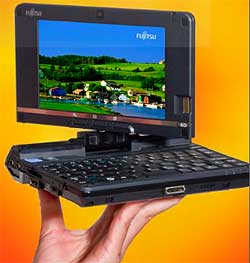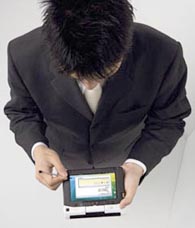Note: On November 4, 2008, Fujitsu introduced the Lifebook U820, an updated version of the U810. Major changes are the switch from an Intel A110 processor to an Intel Atom Z530 CPU, larger hard disks, and inclusion of a GPS receiver and Garmin Mobile PC software. The U820 also supports the draft-N WiFi standard via a new Atheros module, Bluetooth is now Version 2.1, and the integrated vidcam 1.3 megapixel. The keyboard gained a row of keys to more closely resemble a standard QWERTY keyboard, and keypitch is said to have increased from 14 to 15mm, making for a 78.5%-scale QWERTY layout. Battery life with the Atom processor seems quite a bit longer, and so Fujitsu now makes a smaller 2-cell battery available, which is responsible for a new starting weight of just over 1.3 pounds.
 Fujitsu has a long history of making some of the best pen tablet and slates, going all the way back to the dawn of pen computing in the early 1990s. More recently, Fujitsu has added a series of very competent Tablet PC convertible notebooks to its Lifebook line. And the company has also been offering miniature notebooks with touchscreens. They have frequently accompanied Pen Computing Magazine and RuggedPCReview.com staff on trips all over the globe.
Fujitsu has a long history of making some of the best pen tablet and slates, going all the way back to the dawn of pen computing in the early 1990s. More recently, Fujitsu has added a series of very competent Tablet PC convertible notebooks to its Lifebook line. And the company has also been offering miniature notebooks with touchscreens. They have frequently accompanied Pen Computing Magazine and RuggedPCReview.com staff on trips all over the globe.
The U Series, however, is not your standard UMPC. Just like Acer introduced the Tablet PC convertible during the development process of the Micosoft-spec Tablet PC in 2001/2002, Fujitsu is offering a UMPC convertible instead of a little slate. In essence, the Lifebook U820 is a micro PC, smaller by far than an EeePC, that can also be used as a tablet in a way similar to how current Tablet PC convertible notebooks can be used either as standard notebooks or as tablets by rotating to display and folding it down flat onto the keyboard with the LCD facing up.
 The U820 is small. Their 6.75 x 5.25 inch footprint is more like that of an early PDA than any sort of notebook computer. It's just an inch thick, though a bulge at the back adds another quarter of an inch or so, and the footprint grows a bit if you choose the desirable extended battery. And the little machine weighs just 1.3 pounds, far less than any ultra-light notebook. Of course, you also get less computer than with a standard ultra-light. This is, after all, a convertible UMPC.
The U820 is small. Their 6.75 x 5.25 inch footprint is more like that of an early PDA than any sort of notebook computer. It's just an inch thick, though a bulge at the back adds another quarter of an inch or so, and the footprint grows a bit if you choose the desirable extended battery. And the little machine weighs just 1.3 pounds, far less than any ultra-light notebook. Of course, you also get less computer than with a standard ultra-light. This is, after all, a convertible UMPC.
The U Series' display measures just 5.6 inch diagonally and it uses a 1024 x 600 pixel format (the specs mention a 1280 x 800 "internal resolution") with a touchscreen. That means a rather small screen but decent resolution. The picture below, from Fujitsu's Japanese website, shows how the U Series converts from a notebook to a slate.
 On the technology and specification side, things have changed from the original U810. The U Series is now powered by an 1.6GHz Intel A110 processor Atom Z530 with 512KB of L2 cache and a 533MHz frontside bus and an incredibly low thermal design power (TDP) of just two watts. Paired with the Intel SCH US15 chipset, the U820 is clearly designed for energy-efficient operation.
On the technology and specification side, things have changed from the original U810. The U Series is now powered by an 1.6GHz Intel A110 processor Atom Z530 with 512KB of L2 cache and a 533MHz frontside bus and an incredibly low thermal design power (TDP) of just two watts. Paired with the Intel SCH US15 chipset, the U820 is clearly designed for energy-efficient operation.

The U820 can be purchased either with Windows Vista Home Premium of Vista Business. There's still just a single memory slot, occupied by a gig of DDR2 533 SDRAM. Hard disks are still of the 4,200rpm PATA variety, but now range in size from 60 to 120 GB. In terms of connectivity, there is a single USB 2.0 port, audio in/out in a 3.5mm jack, and video-out and LAN for the 10/100 Ethernet connection (via cable and port replicator). The device has both CF Card (3 bottom) and SD card (3) slots, and there is a fingerprint sensor located at the lower left of the screen.
The big news is the integration of a GPS receiver and onboard Garmin Mobil PC software for mapping and street navigation. Add to that a webcam with better resolution (1.3 megapixel instead of just VGA) and the U820 looks like a very versatile little companion indeed.
The keyboard on such a small device cannot be very large, and it isn't. Fujitsu has changed things a bit and added a row of keys and the key pitch now appears to be around 78%-scale. Fujitsu did a commendable job in making most of the keyboard surface available to the standard QWERTY layout (as opposed to wasting valuable real estate with less important function and navigation keys). Navigation is either via manipulation of the resistant-membrane touchscreen, or via a stick point located on the upper left of the keyboard. There is also a scroll button and the standard mouseclick buttons. In tablet mode, the user has access to all those because the top quarter or so of the system unit remains accessible, unlike with most Tablet PC convertibles where the LCD covers the entire bottom part of the notebook.
For the ever-important security, Fujitsu used the TCG 1.2 platform. Between this, the fingerprint sensor, a BIOS password, a hard disk password, Windows login, and the ability to disable the USB port or any other recordable media, the U Series seems adequately protected.
Fujitsu offers two power options with the U820. The standard battery is a 7.2 Volt/2600mAH Li-Ion pack good for 3.5 hours, depending on configuration. A 7.2V/5200mAH long-life battery more than doubles that.
Starting price is US$1,049 and that presents the usual dilemma. It's not much for such a tightly packed techno-marvel, but a good bunch more than one of today's economy notebooks with infinitely more power and features. And worse, also a lot more than the ever-growing number of little netbooks and EeePC-style devices. The market for the U Series will therefore be those who cherish being able to carry a full Vista notebook/slate convertible computer with a keyboard, one that weighs barely more than a pound, can last almost all day on a charge of its extended battery, and can easily be connected to a big screen and full-size keyboard for office work.



